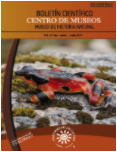Authors
Abstract
Dung beetles are a group of insects widely recognized as ecological indicators of anthropic disturbance, reason why they count with a lot of information at the level of the assemblies. In contrast, population-based studies are still scarce and little has been understood on how fragmentation and transformation of their habitats affect the structure and dynamics of Scarabaeinae populations. Some aspects of the population structure of two typical Scarabaeinae species (Dichotomius cf. satanas and D. cf. alyattes) of the coffee landscape in the Western Andes of Colombia are examined in this paper. Between August 2010 and February 2011, six ecotone transects, each one consisting of 15 non-lethal pitfall traps, primed with a mixture of human and pig excrement, were installed in two coffee growing locations of Risaralda. Each month the traps were active for 48 hours and were inspected every 24 hours. Specimens of both species were labeled with the elytron drilling method in each inspection. A total of 1723 individuals were marked of which 73 were recaptured (43 D. cf. alyattes and 30 D. cf. satanas). The estimated population size differed between species and locations, and the average density ranged between 26.4 and 172.2 ind/km². Both species had similar gender ratio (∼1:1) and showed differences in their habitat preferences: D. cf. satanas tended to stay inside the forest, while D. cf. alyattes used extensively ecotone forest – sun coffee.
References
BADII, M.H., GUILLEN, J., LANDEROS, E., CERNA, Y. & VALENZUELA, J., 2012.- Muestreo por métodos de capturarecaptura. Daena, 7 (1): 97-125.
CULTID, C.A., MEDINA, C.A., MARTÍNEZ, B., ESCOBAR, A.F., CONSTANTINO, L.M. & BETANCUR, N., 2012.- Escarabajos coprófagos (Scarabaeinae) del eje Cafetero: guía para el estudio ecológico. WCS Colombia, CENICAFÉ, Federación Nacional de Cafeteros.
CULTID-MEDINA, C.A., LOBO, J.M., MEDINA, C., GONZÁLEZ, A., ESCOBAR, F. & CHACÓN, P., 2014.- Completitud del inventario de escarabajos coprófagos (Coleoptera: Scarabaeinae) en la Ecorregión del Eje Cafetero, Colombia. Rev. Colomb. Entomol., 40 (1): 111-119.
CULTID-MEDINA, C.A., MARTÍNEZ-QUINTERO, B.G., ESCOBAR, F. & CHACÓN, P., 2015.- Movement and population size of two dung beetle species in an Andean agricultural landscape dominated by sun-grown coffee. J. Insect Conserv., 19 (4): 617-626.
CULTID-MEDINA, C.A. & ESCOBAR, F., 2016.- Assessing the ecological response of dung beetles in an agricultural landscape using number of individuals and biomass in diversity measures. Environ. Entomol., 45 (2): 310-319.
ESCOBAR, F., 1994.- Excremento, coprófagos y deforestación en bosques de montaña al suroccidente de Colombia: Tesis, Universidad del Valle, Cali, Colombia.
ESCOBAR, F. & CHACÓN, P., 2000.- Distribución espacial y temporal en un gradiente de sucesión de la fauna de escarabajos coprófagos (Scarabaeinae, Aphodiinae) en un bosque tropical montano, Nariño-Colombia. Rev. Biol. Trop., 48: 961-975.
ESCOBAR, F., HALFFTER, G. & ARRELLANO, L., 2007.- From forest to pasture: An evaluation of the influence of environment and biogeography on the structure of dung beetle (Scarabaeinae) assemblages along three altitudinal gradients in the Neotropical region. Ecography, 30: 193-208.
HALFFTER, G. & FAVILA, M.E., 1993.- The Scarabaeinae (Insecta: Coleoptera) an animal group for analyzing, inventorying and monitoring biodiversity in tropical rainforest and modified landscapes. Biology International, 27: 15-21.
FERR, F. & HINGRAT, Y., 2004.- Effects of forest fragmentation on a dung beetle community in French Guiana. Conserv. Biol., 19: 1103-1112.
GILL, B.D., 1991.- Dung beetles in tropical American forest: 211-239 (en) HANSKI, I. & CAMBEFORT, Y., (ed.) Dung beetle ecology. Princeton University Press, New Jersey.
GIRALDO, C., ESCOBAR, F. CHARÁ, J.D. & CALLE, Z., 2010.- The adoption of silvopastoral systems promotes the recovery of ecological processes regulated by dung beetles in the Colombian Andes. Insect. Conserv. Diver., 4: 115-122.
HALFFTER, G. & MATHEWS, E.G., 1966.- The natural history of dung beetles of the subfamily Scarabaeinae (Coleoptera: Scarabaeidae). Acta Zoológica Mexicana, 12 (14): 1-312.
HANSKI, I. & CAMBEFORT, Y., 1991.- Spatial processes: 283-304 (en) HANSKI, I. & CAMBEFORT, Y. (ed.) Dung beetle ecology. Princeton University Press, New Jersey.
HANSKI, I. & GILPIN, M., 1991.- Metapopulation dynamics: Brief History and conceptual domain. Biol. J. linn. Soc., 42: 3-16.
HOLDRIDGE, L.R., 1982.- Ecología basada en zonas de vida. Instituto Interamericano de Cooperación de la Agricultura.
JOLLY, G.M., 1965.- Explicit estimates from capture-recapture data with both death and immigration-stochastic model. Biometrika, 52: 225-247.
LARSEN, T. & FORSYTH, A., 2005.- Trap spacing and transect design for dung beetle biodiversity studies. Biotropica, 37: 322-325.
MARTÍNEZ-QUINTERO, B.G., CULTID-MEDINA, C.A. & RUDAS-GRAJALES, J.C., 2013.- Método para marcar escarabajos coprófagos (Coleoptera: Scarabaeidae) y su implementación en los Andes de Colombia. Acta Zoológica Mexicana, 29 (2): 448-451.
MEDINA, C. & GONZÁLEZ, A., 2014.- Escarabajos coprófagos de la subfamilia Scarabaeinae: 194-215 (en) PIZANO, C. & GARCÍA, H. (ed.) El bosque seco tropical en Colombia. Instituto de Investigación de Recursos Biológicos Alexander von Humboldt, Bogotá.
NICHOLS, E., SPECTOR, S., LOUZADA, J., LARSEN, T., AMÉZQUITA, S., FÁVILA, M.E. & THE SCARABAEINAE RESEARCH NETWORK., 2008.- Ecological functions and ecosystems services provided by Scarabaeinae dung beetles. Biol. Conserv., 141 (6): 1461-1474.
NORIEGA, J.A. & ACOSTA, A., 2011.- Population size and dispersal of Sulcophanaeus leander (Coleoptera: Scarabaeidae) on riverine beaches in the Amazonian region. J. Trop. ecol., 27: 111-114.
PECK, S.B. & FORSYTH, A., 1982.- Composition, structure and competitive behaviour in a guild of Ecuatorian rain forest dung beetles (Coleoptera: Scarabaeidae). Can. J. Zoolog., 60: 1624-1634.
ROSLIN, T., 2000.- Dung beetle movements at two spatial scales. Oikos, 91: 323-335.
SEBER, G.A.F., 1982.- The estimation of Animal Abundance and Related Parameters. Griffin editions.
SCHUMACHER, F.X. & ESCHMEYER, R.W., 1943.- The estimation of fish population in lakes or ponds. J. Tenn. Acad. Sci., 18: 228-249.
SPECTOR, S., 2006.- Scarabaeinae dung beetles (Coleoptera: Scarabaeidae: Scarabaeinae) an invertebrate focal taxon for biodiversity research and conservation. The Coleopterist Bulletin, 5: 71-83.
VAN NOUHUYS, S., 2009.- Metapopulation ecology. Disponible en: http://www.eeb.cornell.edu/sdv2/www/data/uploads/pdf/metapopulation-els-2009.pdf.
VILLADA-BEDOYA, S., CULTID-MEDINA, C.A., ESCOBAR, F., GUEVARA, R. & ZURITA, G., 2017.- Edge effects on dung beetle assemblages in an Andean mosaic of forest and coffee plantations. Biotropica, 49 (2): 195-205.

 PDF (Español)
PDF (Español)
 FLIP
FLIP






















